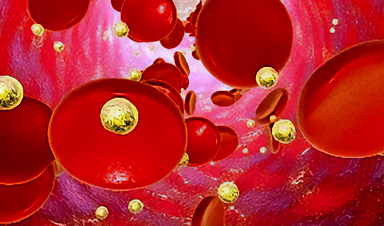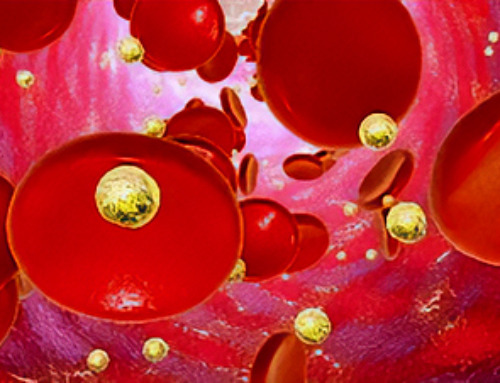| A vaccination as tumor therapy – with a vaccine individually created from a patient’s tissue sample that ” attaches” the body’s own immune system to cancer cells: the basis for this long-term vision has now been achieved by a team of researchers from the MPI for Polymer Research and the University Medical Center Mainz, in particular from the Departments of Immunology and Dermatology. | |
| Their results were recently published in the journal ACS Nano (“Systemically Administered TLR7/8 Agonist and Antigen-Conjugated Nanogels Govern Immune Responses against Tumors”). |
| “We have implemented a new class of vaccines that could form an efficient alternative to mRNA vaccines,” says Prof. Dr. Lutz Nuhn, so far group leader in Tanja Weil’s department at the MPI for Polymer Research and recently appointed as Professor of Macromolecular Chemistry at the Julius-Maximilians-University in Würzburg. | |
| This is important, for instance, for people in whose bodies the production of proteins is disturbed when they are vaccinated with mRNA vaccines – i.e. those that are sometimes used against corona – and for whom these vaccines therefore only have a limited effect. | |
| The main reason, however, is that if Vaccines against cancer are to become the norm one day, various effective strategies must be explored to provide specific immune cells with essential key information. | |
Antigen plus immune activator – coupled to nanoparticles |
|
| The novel vaccine class consists of two components: Firstly, the antigen, which is specific to the tumor cell and is to be recognized by the immune system as an “enemy”, so to speak, and secondly, the immune activator – a “stinger” that shakes up the immune system. | |
| As the immune activator, the researchers use the derivative of a chemical molecule that was discovered by Sunil A. David in the USA and is already being used successfully in the Indian corona vaccine Covaxin. | |
| By itself, this molecule is too active and potent and would cause violent inflammatory reactions throughout the body. Therefore, the research team attaches it to a carrier – more precisely, to polymer-based nanoparticles that have a gel-like consistency, are biodegradable and locally limit the effect of the immune activator. | |
| These nanoscale materials with diameters of less than 100 nanometers are about the size of viruses – the cells of the immune system therefore recognize them very well, eat them and in this way awaken from their dormant mode. The nanoparticles thus open up a direct pathway into the immune system. | |
| And: “By binding them to nanopolymers, we were able to throttle the immune response to the desired level,” explains Nuhn. | |
Vaccine specifically kills tumor cells |
|
| For the vaccine to target the tumor, you need to know: What distinguishes tumor tissue from healthy tissue – in other words, which specific antigens are found on the cancer? This may well be patient-specific. | |
| “If a tumor is diagnosed in the early stages, a race against time begins to produce the patient-specific vaccine as quickly as possible,” Nuhn explains. | |
| To develop the new vaccine classes, the researchers first use a model antigen. They have generated various tumors that carry this model antigen – either on the surface or inside. Initial studies are promising; the T cells activated by the vaccine only kill tumor cells that carry the antigen on their surface or even inside. Healthy tissue, on the other hand, is not affected. | |
| “The polymer-based nanocarrier is a helpful toolbox to further evaluate antigen-specific vaccines and to develop further vaccine-based therapeutic concepts against cancer,” Nuhn is convinced. | |
| One thing must be said, however: Several years of further research will be needed before such vaccines can cure patients of tumors. Nor will it be possible to combat all types of cancer with a vaccine. |
News
Nanocrystals Carrying Radioisotopes Offer New Hope for Cancer Treatment
The Science Scientists have developed tiny nanocrystal particles made up of isotopes of the elements lanthanum, vanadium, and oxygen for use in treating cancer. These crystals are smaller than many microbes and can carry isotopes of [...]
New Once-a-Week Shot Promises Life-Changing Relief for Parkinson’s Patients
A once-a-week shot from Australian scientists could spare people with Parkinson’s the grind of taking pills several times a day. The tiny, biodegradable gel sits under the skin and releases steady doses of two [...]
Weekly injectable drug offers hope for Parkinson’s patients
A new weekly injectable drug could transform the lives of more than eight million people living with Parkinson's disease, potentially replacing the need for multiple daily tablets. Scientists from the University of South Australia [...]
Most Plastic in the Ocean Is Invisible—And Deadly
Nanoplastics—particles smaller than a human hair—can pass through cell walls and enter the food web. New research suggest 27 million metric tons of nanoplastics are spread across just the top layer of the North [...]
Repurposed drugs could calm the immune system’s response to nanomedicine
An international study led by researchers at the University of Colorado Anschutz Medical Campus has identified a promising strategy to enhance the safety of nanomedicines, advanced therapies often used in cancer and vaccine treatments, [...]
Nano-Enhanced Hydrogel Strategies for Cartilage Repair
A recent article in Engineering describes the development of a protein-based nanocomposite hydrogel designed to deliver two therapeutic agents—dexamethasone (Dex) and kartogenin (KGN)—to support cartilage repair. The hydrogel is engineered to modulate immune responses and promote [...]
New Cancer Drug Blocks Tumors Without Debilitating Side Effects
A new drug targets RAS-PI3Kα pathways without harmful side effects. It was developed using high-performance computing and AI. A new cancer drug candidate, developed through a collaboration between Lawrence Livermore National Laboratory (LLNL), BridgeBio Oncology [...]
Scientists Are Pretty Close to Replicating the First Thing That Ever Lived
For 400 million years, a leading hypothesis claims, Earth was an “RNA World,” meaning that life must’ve first replicated from RNA before the arrival of proteins and DNA. Unfortunately, scientists have failed to find [...]
Why ‘Peniaphobia’ Is Exploding Among Young People (And Why We Should Be Concerned)
An insidious illness is taking hold among a growing proportion of young people. Little known to the general public, peniaphobia—the fear of becoming poor—is gaining ground among teens and young adults. Discover the causes [...]
Team finds flawed data in recent study relevant to coronavirus antiviral development
The COVID pandemic illustrated how urgently we need antiviral medications capable of treating coronavirus infections. To aid this effort, researchers quickly homed in on part of SARS-CoV-2's molecular structure known as the NiRAN domain—an [...]
Drug-Coated Neural Implants Reduce Immune Rejection
Summary: A new study shows that coating neural prosthetic implants with the anti-inflammatory drug dexamethasone helps reduce the body’s immune response and scar tissue formation. This strategy enhances the long-term performance and stability of electrodes [...]
Scientists discover cancer-fighting bacteria that ‘soak up’ forever chemicals in the body
A family of healthy bacteria may help 'soak up' toxic forever chemicals in the body, warding off their cancerous effects. Forever chemicals, also known as PFAS (per- and polyfluoroalkyl substances), are toxic chemicals that [...]
Johns Hopkins Researchers Uncover a New Way To Kill Cancer Cells
A new study reveals that blocking ribosomal RNA production rewires cancer cell behavior and could help treat genetically unstable tumors. Researchers at the Johns Hopkins Kimmel Cancer Center and the Department of Radiation Oncology and Molecular [...]
AI matches doctors in mapping lung tumors for radiation therapy
In radiation therapy, precision can save lives. Oncologists must carefully map the size and location of a tumor before delivering high-dose radiation to destroy cancer cells while sparing healthy tissue. But this process, called [...]
Scientists Finally “See” Key Protein That Controls Inflammation
Researchers used advanced microscopy to uncover important protein structures. For the first time, two important protein structures in the human body are being visualized, thanks in part to cutting-edge technology at the University of [...]
AI tool detects 9 types of dementia from a single brain scan
Mayo Clinic researchers have developed a new artificial intelligence (AI) tool that helps clinicians identify brain activity patterns linked to nine types of dementia, including Alzheimer's disease, using a single, widely available scan—a transformative [...]





















